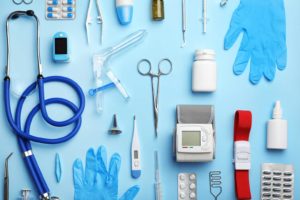Medical devices are any type of device used for diagnosis, treatment, or prevention of disease or other medical conditions. The U.S. Food and Drug Administration (FDA) regulates all medical devices sold in the United States, from contact lenses and hearing aids to stents and defibrillators. To ensure devices are safe and effective, the FDA has developed a medical device classification system based on their risk profile. Before starting your regulatory pathway, you must determine your product’s correct classification.
Medical Device Classification and Regulatory Controls
Medical devices are defined as follows by Section 201(h)(1) of the Food, Drug, and Cosmetic Act: an instrument, apparatus, implement, machine, contrivance, implant, in vitro reagent, or other similar or related article, including a component part or accessory which is:
- (A) recognized in the official National Formulary, or the United States Pharmacopoeia, or any supplement to them,
- (B) intended for use in the diagnosis of disease or other conditions, or in the cure, mitigation, treatment, or prevention of disease, in man or other animals, or
- (C) intended to affect the structure or any function of the body of man or other animals, and which does not achieve its primary intended purposes through chemical action within or on the body of man or other animals and which does not achieve its primary intended purposes through chemical action within or on the body of man or other animals and which is not dependent upon being metabolized for the achievement of its primary intended purposes. The term “device” does not include software functions excluded pursuant to section 520(o).
Devices fall into one of three classes based on risk: Class I (low risk), Class II (medium risk), or Class III (high risk). There are different regulatory controls (General, Special) with and without exemptions based on the classification of the device. General Controls are regulatory requirements that apply to all devices unless exempt by regulations under the device classification code. Special Controls are specific to devices in which General Controls alone cannot provide a reasonable assurance of safety and effectiveness.
Class I Devices
Class I devices are low-risk, meaning they are not life-sustaining, life-supporting, or implantable devices that require general controls. Most Class I devices require self-registration with FDA or some require a 510(k) pre-market notification.
Examples of Class I Medical Devices:
-
-
- Bandages
- Non-Electric Wheelchairs
- Stethoscopes
- Latex Gloves
-
Class II Devices
Class II medical devices are medium-risk medical devices that do require general controls and special controls to provide reasonable assurance of safety and effectiveness. Most Class II devices are cleared under a 510(k) pre-market notification. Few devices under Class II are approved via a PMA. 10-15% of Class II devices require clinical data.
Examples of Class II Medical Devices:
-
-
- Thermometers
- Syringes
- Blood Pressure Cuffs
- Contact Lenses
-
Class III Devices
Class III Medical Devices are high-risk medical devices that may pose serious risks to health and require general controls and special controls if applicable with PMA approval by the U.S. Food and Drug Administration (FDA) before they can legally be marketed in the United States. Almost all PMAs submitted require clinical data.
Examples of Class III Medical Devices:
-
-
- Automated External Defibrillator (AED)
- Pacemakers
- Breast Implants
- Heart Valves
-
Determination of Regulatory Requirements
Not all medical devices are the same, so their regulatory pathway is determined by many elements. These elements include classification of the device, intended use of the device, the degree of risk to health, and regulatory controls like Good Manufacturing Practices (GMP) and Special Controls (Performance Standards).
To determine your device classification:
-
- Determine if a similar product is on the market and perform a search in the FDA Classification Database.
- Hire a consultant to help determine the classification of the device.
- Contact Device Determination at FDA
- Submit a 513(g) to the FDA.
FDA Product Classification Database
The FDA’s product classification database is a tool that serves as an authoritative reference for the classification of products. The database contains regulatory information to search to define the classification and regulatory controls for a medical device.
This electronic database is searchable by many features, including device name, product code, regulation number, review panel, and more.
Find A Wright Path to Meeting Regulatory Requirements
Determining medical device classification is just the beginning of getting your medical device to market. The experts at A Wright Path can help you determine your regulatory pathway and meet all regulatory requirements. Schedule a consultation today to learn how A Wright Path can help you gain clearance or approval from the Food and Drug Administration (FDA), submit a 510(k) or 513(g) to FDA, develop a clinical trial strategy, determine your device classification, and more.



